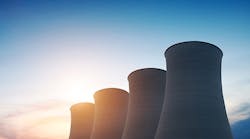I was born in the era of Atoms for Peace — President Eisenhower’s Cold War strategy to shift the focus from the horror of Hiroshima and Nagasaki to the hope of peaceful, productive and profitable uses for nuclear power. That strategy made some headway. From small beginnings in the 1960s, nuclear power generation expanded rapidly around the world through the 1970s, 80s and 90s. However, safety concerns — punctuated by the Chernobyl disaster of 1986 — together with rapid cost escalation, put a damper on growth. Despite these setbacks, nuclear power today represents 10% of electric generation globally; in some countries — such as France (70%) and Sweden (40%) — the percentage is much higher. (Data from Our World in Data, accessed 01/22/2022.)
Recent events in Eastern Europe have reawakened the specter of nuclear holocaust. However, we are in a new era, where climate change and the pressing need for decarbonization are front and center. Nuclear power has long been recognized as a massive opportunity for low carbon energy, and that includes applications within the process industries. The critical question is, has the technology matured to the point where we can capture this potential both safely and economically? In my view, the answer is — maybe. There have been big improvements; the most promising is the development of small modular reactors (SMRs).
Full-scale conventional nuclear power plants are typically of gigawatt capacity. For example, each of the two South Texas units in Matagorda is rated at 1,280 MW(e). In contrast, SMR designs range from 10–300 MW(e), with a subclass of microreactors less than 10 MW(e). The sizes mean these units can be deployed for relatively small off-grid applications in remote regions, and they also make SMRs accessible for a host of commercial and industrial applications. These new designs incorporate a range of safety improvements, such as high-pressure containment vessels and passive reactor cooling, which dramatically reduce the risk of releasing fission products and radiation. The modules can be substantially manufactured in a factory and installed at the site rather than constructed on-site — a huge cost saving. Also — important for applications in the process industries — most designs include the option of exporting steam, which can be used for process heating and other applications.
One application of nuclear energy that has attracted a lot of attention recently is the production of so-called “pink hydrogen” — hydrogen generated through electrolysis of water by using electricity from a nuclear power plant. However, SMRs open up a much larger range of decarbonization opportunities. A study in 2014 examined ways to provide both heat and power to an oil refinery from light-water SMRs (D.T. Ingersoll, C. Colbert, R. Bromm and Z. Houghton, “NuScale Energy Supply for Oil Recovery and Refining Applications,” paper 14337, Proceedings, ICAPP 2014, Charlotte, N.C., April 6–9, 2014,). The same study identified a wide range of chemical and petrochemical processes, producing products as diverse as ethylbenzene, terephthalic acid, urea, soda ash, and nylon 6.6 that would be amenable to a similar heat and power system.
No SMRs have been deployed yet in the United States. However, that is about to change. The first U.S. commercial deployment contract was signed in December 2020. The Utah Associated Municipal Power Systems (UAMPS) awarded design and licensing scope to Fluor for the Carbon Free Power Project (CFPP) to build a NuScale VOYGR-6 on the Idaho National Laboratory site. This 6-reactor, 462-MWe (gross) power plant will be approved by the Nuclear Regulatory Commission for construction and operation by 2026, with initial operations in 2029; it should be 100% operational in 2030. Fluor and NuScale have agreed to deliver this plant at or below a levelized cost of electricity of $58/MWh. The U.S. Department of Energy has committed a grant of $1.36 billion to UAMPS for the site-specific design and construction of the CFPP to de-risk this first-of-a kind-reactor deployment. The project economics are aided by advanced nuclear production tax credits (PTCs) that will allow new SMR projects to receive PTCs for the first eight years of operations. Frank Dishongh, president, Fluor Nuclear Project Services, has great confidence in the NuScale technology. He describes it as “a safe, affordable, resilient, carbon-free power source for industries and utilities.”
Perhaps your plant could host the first deployment in the process industries.


